#so i could crank out some new sprites and start new adventures and stories
Explore tagged Tumblr posts
Text
Scrolling through asks on my old blog to work on getting some quirks noted down and damn I miss some of these losers 😭
#ooc#vent#ish#I picked who I did to start with over here because a lot of my older trolls have close ties with the characters of someone who doesn't#really do troll things anymore#though he's started making new characters and designs so it's not like he and his characters are 100% fore sure gone so its#complicated#I wish I was able to work on art as easily as i used to#so i could crank out some new sprites and start new adventures and stories
5 notes
·
View notes
Text
Ninja Gaiden Spotlight: Ninja Gaiden Shadow & Shadow of the Ninja

While the series faded away almost as quickly as it started, Ninja Gaiden spread itself out across a wide variety of systems during its brief run at the top. While the NES trilogy proved to be of a level of quality none of the other contemporary games in the series could live up to, some of these other spins on Ninja Gaiden were still decent. The best of the bunch came mere months after the release of Ninja Gaiden 3 with Ninja Gaiden Shadow's release on the Nintendo Game Boy. Interestingly enough, it wasn't even intended to be a Ninja Gaiden game until almost the last minute. This article looks at Natsume's contribution to the series, which made a curious cousin out of what had been an unrelated title.
Ninja Gaiden Shadow
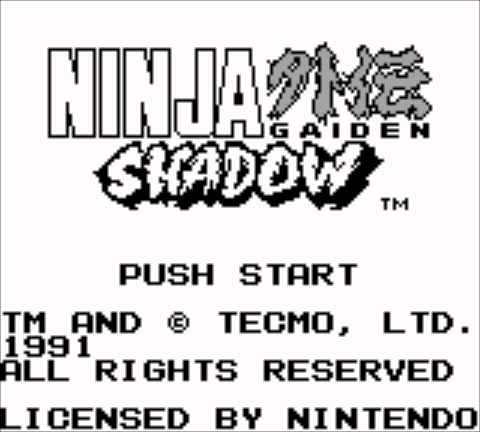
Original Release Date: December 13, 1991 (JPN)
Original Hardware: Nintendo Game Boy
When Nintendo's Game Boy arrived on the scene in the spring of 1989, it opened up a lot of doors for publishers who had found success on Nintendo's first home console, the 8-bit NES. Not only was it a new platform to release games on, it was a new platform whose audience could be somewhat reliably counted upon to already have knowledge of brands that were popular on the NES. Indeed, almost all of the big third-party NES hits made at least one appearance on the handheld. Castlevania, Contra, Mega Man, Double Dragon, Adventure Island, Gradius, and many more player favorites did their best to give the NES experience on the go, to varying degrees of success. So it's no wonder that Tecmo sought to do the same with Ninja Gaiden, which was at the time their strongest worldwide brand.
With the console team cranking out annual sequels, however, there was no time for them to handle a Game Boy game. Similarly, other teams at Tecmo had their own fairly popular franchises to work on, so they couldn't be pulled away either. Tecmo finally found their answer in an unlikely place. In the years before they would become well-known as the publisher of Harvest Moon, Natsume mostly made side-scrolling action games for publishers like Taito and Jaleco. These weren't top-shelf efforts by any means, but they were decent enough, particularly given half of them were licensed games, a category for which the quality bar was quite low on the NES.

One of their original efforts, and I use that term somewhat loosely, was called Shadow of the Ninja. It's hard to say if it was inspired by Ninja Gaiden, though it very well may have been. The game sold well enough, so Natsume got to work on a Game Boy version. A few months before it was finished, Tecmo stepped in and bought the publishing rights to the game. A few swapped sprites, some added music, an extra line of text or two, and a minor mechanical adjustment later, Shadow of the Ninja for Game Boy had become Ninja Gaiden Shadow. It's not a total cover-up job, as huge chunks of Shadow of the Ninja are still in the game as-is. That’s probably why it hasn't been re-released on the Virtual Console or in any compilations.
Given the history behind its development, it's hardly surprising that Ninja Gaiden Shadow doesn't play much like the NES games. The funny thing is, this wasn't out of the ordinary for Game Boy versions of NES franchises. Castlevania Adventure didn't play much like the NES games, after all, and even Mega Man had a different feel thanks to the modified screen proportions. So when Ryu Hayabusa couldn't stick to walls or use any ninja arts save the Fire Wheel, it was just assumed by many that it was just another case of a stripped back Game Boy installment. Plus, whether by design or circumstance, Ryu had already adopted the hand-over-hand ceiling that was characteristic of Shadow of the Ninja in Ninja Gaiden 3, which had released by the time Ninja Gaiden Shadow came out. If you didn't know the story behind Ninja Gaiden Shadow's or hadn't played Shadow of the Ninja, you would be forgiven for thinking this was just a quirky cousin.
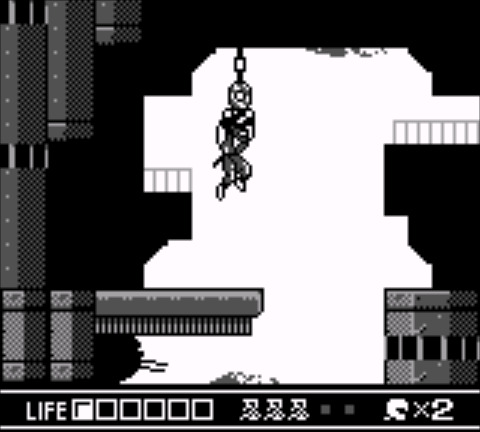
Like a lot of early Game Boy action games, Ninja Gaiden Shadow is quite short on content. There are only five stages, and they're much shorter than anything seen in the NES games. While there are a few sections where the stages scroll vertically, you're mostly walking from left to right killing bad guys, occasionally switching between the ceiling and the floor as needed. Without the wall-climbing of the NES games, there's a lot less to worry about in terms of navigating hazards, and the many bottomless pits of the main franchise are few and far between here. Power-ups are limited to extra lives, health restoratives, and ninja magic points. Ryu only has access to the Fire Wheel ninja magic in this game, with each use costing one magic point. You can stockpile a maximum of five points, and if you die, you'll lose all but one point. Ryu can stab at enemies using his Dragon Sword from standing, ducking, and hanging positions. He can also employ a grappling hook to reach higher ceilings. It only goes straight up, so don't expect any fancy Bionic Commando shenanigans here.
Perhaps the most striking difference is the overall lack of cinematic cut-scenes. It uses a slightly modified version of Shadow of the Ninja's opening, but other than that, all we get are simple animations showing Ryu killing each of the bosses. A few stills done in the same art style as the NES games accompanied by a loose story would have gone a long way towards making this feel like more of a proper chapter, I think. As it is, it ends up feeling like exactly what it is: a stripped-down Shadow of the Ninja with a few Ninja Gaiden elements jammed in where there was time to fit them. It's not terrible, especially given the standards of action games on Nintendo's handheld early on, but it's largely forgettable.

When compared to the NES games, Ninja Gaiden Shadow is generally a much easier game to get through. The bosses can be quite difficult, but since the whole game doesn't last much longer than a half hour or so, even a full restart doesn't feel like the end of the world. The most difficult part of the game is the final crawl towards the end boss, but even in that regard, it's nowhere near as hard or mean-spirited as the NES games could be. Plus, there's only one final boss. Okay, he has two forms, but they flow together into one fight. Take him down and you get a nifty animated scene of Ryu finishing him off and walking into the proverbial sunset. Strangely, this game is meant to take place years before the battle with Jaquio, so I guess Ryu just forgot about all of this afterwards.
It's hard to say if Tecmo would have been interested in doing another Game Boy Ninja Gaiden if circumstances had been different. The franchise was quickly burning out, and the Game Boy's situation was looking quite grim prior to its miraculous resurrection at the hands of Pokemon. In any case, Natsume's own situation got very complicated soon after this game's release, so I imagine any hope of a second Ninja Gaiden Shadow fell by the wayside. It's probably just as well. The Game Boy wasn't especially well-suited for action games like Ninja Gaiden, and even the slower pace of Shadow of the Ninja wasn't a perfect fit. The Ninja Gaiden series wouldn't see another original handheld release until 2008's Ninja Gaiden: Dragon Sword, a creative Nintendo DS riff on the Xbox revival.
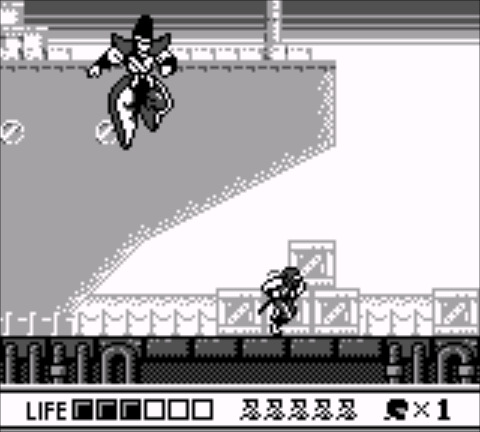
Shadow of the Ninja

Original Release Date: August 10, 1990 (JPN)
Original Hardware: Nintendo Famicom
While it might seem strange to cover Shadow of the Ninja while leaving out honest-to-goodness Ninja Gaiden games like the Game Gear installment, in the interests of being thorough I thought it would be a good idea to check out the game that Ninja Gaiden Shadow was spawned from. It also doesn't hurt that, unlike Ninja Gaiden Shadow, Shadow of the Ninja is readily available through the Virtual Console service on various Nintendo platforms. If you want to do things by the book, the easiest access to a Ninja Gaiden Shadow-like experience is in playing this NES game instead. That it's the better game of the two serves as a nice bonus, too.
It's rather interesting that Shadow of the Ninja ended up being the basis for a Ninja Gaiden game, because as much as the ninja set-dressing fits, the pacing and flow of the game is closer to something like Mega Man or Castlevania. The NES Ninja Gaiden games are constantly pushing the player to move, move, move. Almost every enemy goes down in a single hit, respawns if you so much as look at them funny, and is carefully positioned to knock you to your doom if you stop to take a breath. By contrast, Shadow of the Ninja has a more deliberate speed to it. You're free to take as much time as you want to assess the situation, apart from a couple of sections where something deadly is chasing behind you. Almost all of the enemies take multiple hits before going down, and even the bosses are hit-sponges on a level Ninja Gaiden could only dream of. It's also absolutely vital that you pay attention to which items you're picking up, as an abrupt and ill-advised weapon change can put you in a real bad spot.
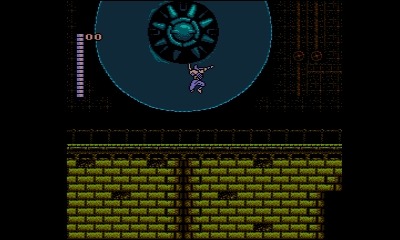
Another way it separates itself from Ninja Gaiden is in how its level structure, lives, and continues are set up. Your life meter carries over from map to map, and even beating a boss only restores a portion of any lost damage. There are health pick-ups strategically placed around each level, but due to the basic set-up, every hit counts for a lot. There are no extra lives, and you get a mere five continues to make it to the end of the game with. It's not impossible by any means, but you really do need to run a tight ship here on a scale that wasn't necessary in most other NES side-scrollers. There are five chapters to the game, each with two or three stages and a boss encounter. One nice concession is that falling down a pit doesn't automatically kill you, instead penalizing you for a certain amount of life points and respawning you.
One of the more notable unique points of Shadow of the Ninja is its support for simultaneous two-player co-op. There are two characters, a male ninja and a female ninja. While their appearances differ, they are mechanically identical in all respects. If you're playing by yourself, you can take your pick of the two, which is a fun extra. In two player mode, each player takes control of one of the ninjas. Having a second pair of hands can be enormously useful, but there is a serious catch. Those five continues I mentioned? If you're playing two-player, you have to share those. No fighting over the remainder, friends. I'm sure two skilled players could make ground beef out of the game in the co-op mode, but for my purposes, it was a lot easier to go it on my own. One nice point for Virtual Console players is that you can make use of the 3DS Download Play feature to get a co-op game going, if that's how you want to roll.
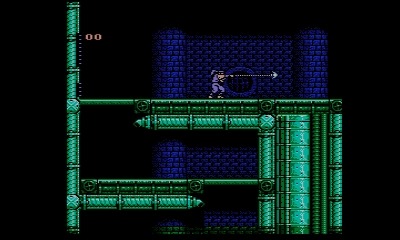
Shadow of the Ninja can be beat by one player, but there were spots along the way that really felt like they were meant for two. Take the basic weapon system, for example. You start off with a katana that has a very short range. It won't be long before you find a kusarigama, a sort of weighted chain. It has a long range but will only do damage with the tip, so if anyone gets in close, you'll be in a pinch. The game rewards you for sticking with one weapon. Collecting an icon that matches your currently-equipped weapon will power it up a level, while changing weapons knocks it right back down to its regular form. At the same time, certain enemies and situations are best handled with one weapon of the two, so if you don't change weapons you're going to have a harder time. Ideally, you'd probably have one player stick with swords and the other with chains, but if you're on your own, you'll have to make do.
Things heat up in Shadow of the Ninja a lot quicker than they do in Ninja Gaiden. By the second stage, you're already getting overwhelmed with speedy enemies that aren't afraid to press you. While you're going to want to memorize as much as you can, it also helps to take things slowly. There's no timer in this game, so you can move at your own pace. I found that stopping and assessing each area helped me find the best way through. While it might seem like weapon power-ups are just scattered around, there's often a method to the arrangement.
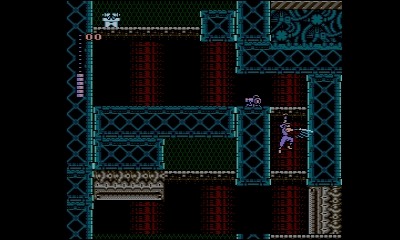
For example, one stage late in the game has a kusarigama just before an enemy that's out of reach. You might be tempted to grab it because it makes dispatching that enemy easier. But if you leave it and jump the gap, you'll be able to use your sword to pick up a shuriken power-up that makes clearing the next few enemies a lot easier. Once you've beaten them, you can go back and collect the kusarigama for use against the stage boss, where it's virtually necessary for a victory. That's almost like a puzzle, and it's not something you would expect from a game like this.
The game's other claim to fame is in its hand-over-hand climbing move. Your character can cling to certain ceilings, shimmy along, and flip up over top of them. Similarly, you can also fall through certain floors and cling to their undersides. Many of the game's navigational challenges require deft use of this move, and it's also important for making certain enemy groups easier to tackle. The grappling hook found in Ninja Gaiden Shadow isn't included here, so you can only stick to ceilings you can reach by jumping. Still, it's a cool move and a good way of making the action play out differently from Ninja Gaiden's wall-jumping antics. It seems extremely likely that Tecmo took inspiration from Shadow of the Ninja for Ryu's new hand-over-hand move in Ninja Gaiden 3. Turnabout is fair play, I suppose.
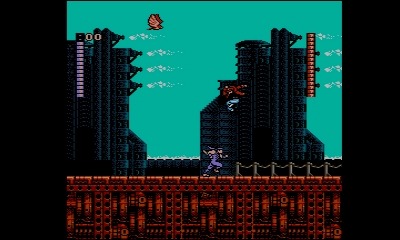
Although it comes on a bit stronger in the beginning, I think Shadow of the Ninja is an easier game than Ninja Gaiden. The life system is strict, but the health pick-ups are placed sensibly to give you a recharge right when you usually need one. The final stretch towards the last boss and the boss himself are absolutely brutal, but it's no worse than the first Ninja Gaiden game's closing areas. One thing I don't like is how many hits the bosses take, though. They have life meters but you'll often have to hit them a ridiculous amount of times before you'll see any change in those meters. Their behaviors aren't all that complex, with only a few different attack patterns each. Once you've learned how to avoid their attacks and get in your own licks, boss battles turn into long slogs of doing the same couple of things over and over again. It's the one sour note on what I feel are mostly better boss encounters than the ones found in the Ninja Gaiden games.
Shadow of the Ninja may be considered family to Ninja Gaiden, but only in the in-law sense. The game feels quite different from Ninja Gaiden on a fundamental level, really only sharing the core idea that ninjas are pretty awesome. It's a pretty difficult game, but that's hardly a rare trait in games of this vintage. What is rare is that simultaneous co-op mode, and while I think the average player is better off going it alone, you'll likely have more fun as a pair. It's a meat-and-potatoes NES action game, and while it probably won't make it into the history books for anything in particular, it's better than you might expect it to be. Oh, and the music is pretty fantastic, too. Shadow of the Ninja certainly makes for a nice chaser after running through the Ninja Gaiden NES trilogy, if nothing else.
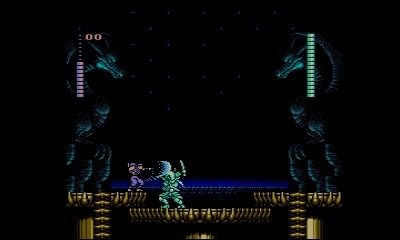
Previous: Ninja Gaiden 2 & Ninja Gaiden 3
Next: Ninja Gaiden (Master System) & Ninja Gaiden Trilogy
If you enjoyed reading this article and can’t wait to get more, consider donating to the Post Game Content Patreon. Just $1/month gets you early access to articles like this one, along with my undying thanks.
#ninja gaiden spotlight#ninja gaiden#gaming#retro#ninja gaiden shadow#game boy#nes#shadow of the ninja#tecmo#natsume
0 notes